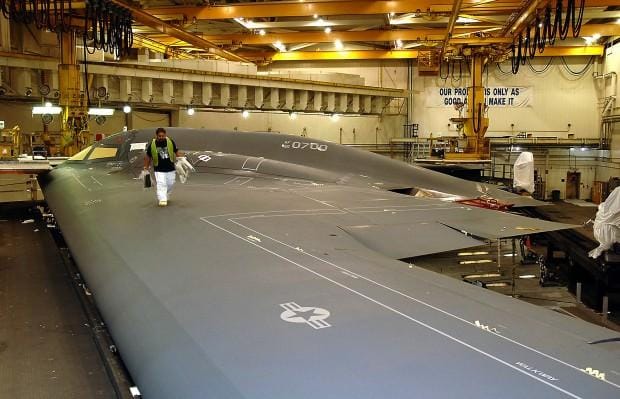LOS ANGELES - Hunched over, her eyes fixed downward, Tanya Hart inches across the vast wing of the B-2 stealth bomber one small step at a time, looking for any nicks or hairline scratches in the freshly repainted surface.
Even a tiny blemish could make the B-2 as visible on radar screens as a giant flying tin can. Hart, 50, is the last line of defense for what may be the world's most expensive paint job.
"This isn't a job where you can afford to mess up," said Hart, a "surface technician" for Northrop Grumman Corp., which built the bombers and is now overhauling them.
The B-2 has been called one of the greatest achievements in military technology since the atom bomb. But keeping the massive, bat-winged plane from being detectable by radar is no easy task. It's not cheap, either.
Overhauling a stealth bomber, which must be done every seven years, costs $60 million, on average, and usually takes a year.
Complete overhaul
The work is done at Northrop's 45-acre complex in Palmdale, Calif., where hundreds of workers strip off the plane's paint, panels, nuts and bolts, right down to the frame, before rebuilding it with new paint, parts and equipment.
The cost may be staggering, but the B-2 is no flying bus. Considered the world's most technologically advanced aircraft, it can evade radar to slip behind enemy lines and knock out air defense systems and anti-aircraft missiles.
The 20 B-2s in service were built at a cost of over $2.1 billion each, with many parts one-of-a-kind. Contributing to the high cost of an overhaul is the meticulous care that must be taken in restoring the bomber's dark gray coating, known as "advanced high-frequency material," which is the key to keeping it nearly invisible to radar.
Even so, the overhaul costs are a sore point with some military industry critics who have long called the B-2 a gold-plated boondoggle.
"It's the ultimate hangar queen," said Winslow T. Wheeler, an analyst at the Center for Defense Information, a Pentagon watchdog group.
The bomber, he said, is not useful for waging the kind of warfare being fought today against low-tech enemies. "It's irrelevant in the wars in Iraq and Afghanistan," he said.
The Air Force spent more than $800 million last year upgrading, maintaining and overhauling the stealth bomber fleet. For each hour it's in the air, a bomber spends 50 to 60 hours on the ground undergoing maintenance.
The Pentagon, however, contends that it needs the bomber to extend U.S. military might.
No new bomber soon
In February, Defense Secretary Robert M. Gates said he did not expect the Air Force to develop and field a new bomber for nearly two decades, leaving the B-2 as the nation's most advanced bomber for the foreseeable future.
The B-2 has seen action in both Iraq and Afghanistan, flying into heavily defended areas and clearing the way for other fighters and bombers by knocking out radar installations. Its debut came in 1999 in the Balkans, when several B-2s flew nonstop to Kosovo from their home base in Missouri to bomb bridges and a tank-making factory.
The U.S. government lifted the veil on the super-secret B-2 stealth bomber program in 1988, exposing one of the largest weapons development efforts since the Manhattan Project produced the atomic bomb. The Air Force and Northrop went to great lengths to conceal even the smallest detail.
Thousands of jobs
The first B-2 rolled off the assembly line in 1988; the last in 1997. At its height, the program involved about 40,000 employees at aerospace facilities all over the country, including about 15,000 in the Southland. It continues to provide work to about 1,200 people, many of them at Northrop's facilities in Palmdale where the B-2s were assembled.
It's expensive to maintain because it is a technological marvel, said John Pike, director of Globalsecurity.org, a website for military policy research. "It's a complicated plane, so it's difficult to care for," he said. "Most of the time there are more B-2s on the rack than on the ramp."
The work is done in custom-built hangars that have special filtered vents for keeping the interior free of dust and maintaining a constant temperature year-round.
That's because the B-2's coat, which acts more like a skin than paint, is sensitive to heat and humidity. The high-tech coating acts like a sponge that absorbs radar waves as they strike the plane.

